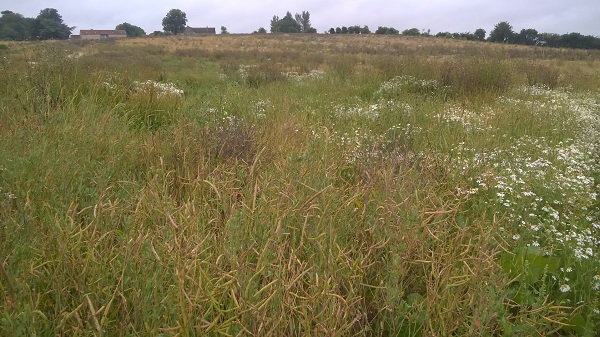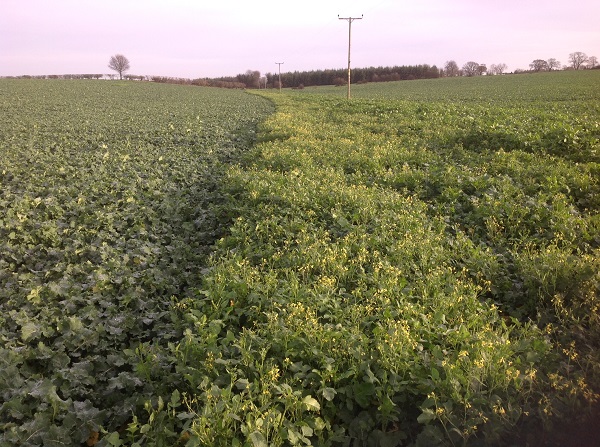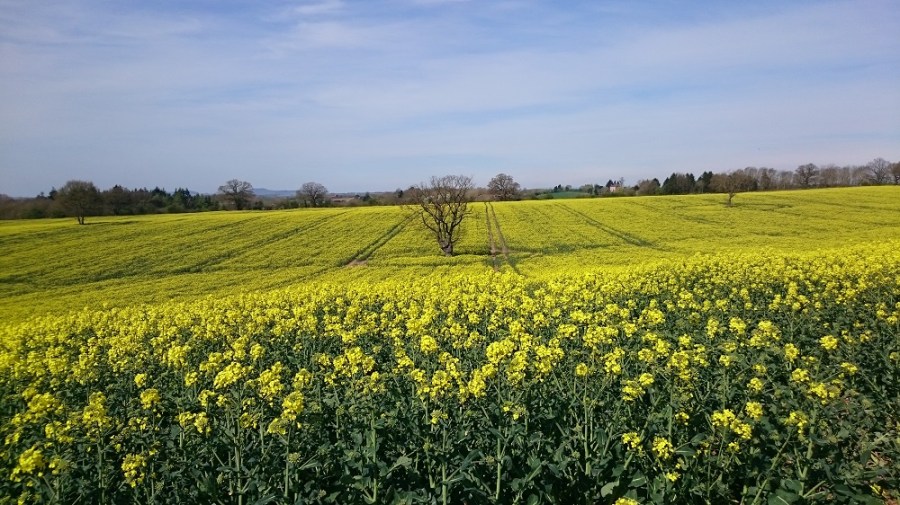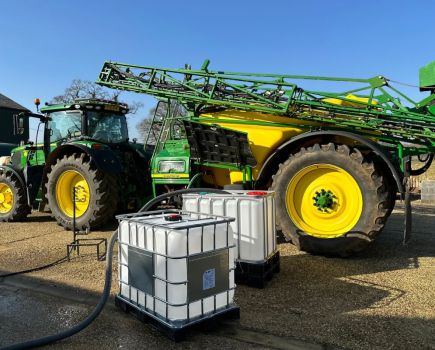The UK area of herbicide-tolerant Clearfield oilseed rape doubled to 30,000ha last year, with further increases predicted. CPM explores how to get the best from the system.
Clearfield OSR is a brilliant tool in the armoury on difficult areas of the farm where weed pressure has got too high.
By Paul Spackman
New varieties and improved understanding of how to tailor farm agronomy around the Clearfield concept have fuelled interest in this novel approach to growing oilseed rape since it came to market in 2010.
Ten Clearfield (CL) varieties are available from three breeders (see below), all traditionally bred with tolerance to the imidazolinone group of ALS inhibitor herbicides, which includes post-emergence imazamox-based Cleranda (imazamox+ metazachlor) and Cleravo (imazamox+ quinmerac).
The approach allows a wider application window and more flexibility for broadleaf weed control compared to traditional pre-emergence strategies, alongside many other benefits (see box), says BASF business development manager Clare Tucker.
Seven years of commercial experience and new varieties with better agronomics and yield potential have dispelled many early anxieties about the system which she believes can improve crop profitability on a range of farms.
However, good agronomy is required to get the best from varieties and herbicides.
Imazamox is a selective herbicide that works by inhibiting the enzyme acetolactate-synthase (ALS) which causes restricted growth and cell development in susceptible weeds.
Herbicides should therefore be applied to small, actively growing weeds that are more susceptible and readily take up the herbicide. The optimum timing is when weeds are at 1-4 true leaves, which usually occurs between mid-Sept and mid-Oct, explains Clare Tucker.
Treating larger weeds is likely to result in slower, more variable control and risks compromising yield potential, so it’s not worth delaying applications even if later germinations are expected, she says. Runch can be particularly problematic if allowed to grow too big as reserves within its large tap root may allow regrowth after treatment, she notes
“Timing can be tricky,” adds Agrovista’s southeast technical support manager Rob Purvis, “especially with charlock where weed germination can occur with the crop, followed by another flush later.
“You need to balance mopping up later emerging weeds while not allowing early weeds to get too big. If germination is protracted it’s better to treat most at four leaves and follow up later with alternative chemistry if required.”
Fantastic control
Rob Purvis reports “fantastic control” of weeds such as charlock, runch, hedge mustard and shepherd’s purse from using the Clearfield system, with one Kent trial delivering more than 95% control.
All weeds can be hard to control in OSR given limited chemical options, he says.
Experts point out that although Clearfield herbicides provide wide weed control and mop-up cereal volunteers there’s still a case for other chemistry in the programme.
For example, propyzamide or carbetamide will be required later in the season for blackgrass control, says Clare Tucker. Where high populations of early weeds are expected, such as cranesbill which can grow quickly ahead of others, then a low dose pre-em provides a “belt and braces” approach.
Frontier crop production specialist Paul Cartwright says an early residual used prior to the Clearfield herbicide can be particularly effective. Frontier trials have shown low-dose metazachlor applied pre-emergence followed by metazachlor-free Cleravo post-emergence gave better control of shepherd’s purse than using Cleravo alone. A similar result was achieved with groundsel, he notes.
“Clearfield herbicides are very effective if you get good contact with the weed leaf, but imazamox is mainly contact-acting with little residual activity. There may well be cases where other actives should be used in a programme tailored around the Clearfield system to ensure no gaps in control.”
Rob Purvis also suggests there may be a case for including a pre-em herbicide where cranesbill is a particular problem. He recommends Springbok (dimethenamid-P+ metazachlor).
Clearfield herbicides are primarily absorbed by foliar uptake through the leaf, so good spray coverage is essential. Clare Tucker says a “medium” quality spray applied at a water volume of 100-200 l/ha is usually sufficient.
Ensuring herbicides have time to dry onto the leaf surface before rain is essential for optimum uptake and efficacy. Products are rainfast in 2-3 hours and she advises against spraying when conditions are very damp.
Water stewardship guidelines should be followed to minimise the risk of active ingredients (notably metazachlor or quinmerac) entering watercourses, she adds. See https://agriculture.basf.com/gb/en/Crop-Protection/Metazachlor-Stewardship/Metazachlor-Stewardship/Metazachlor-Stewardship.html
For best weed control BASF also says to follow the recommended label rates of 2 l/ha for Cleranda and 1 l/ha for Cleravo and always add the adjuvant Dash at 1 l/ha.
Good stubble hygiene after growing Clearfield OSR is key to minimising the risk of herbicide-tolerant volunteers emerging in following crops that’ll be hard to control with ALS inhibitor chemistry.
Rob Purvis advises against cultivating stubbles straight after harvest to allow spent seed on the surface to germinate in light and moisture. “It’s a strategy that applies to all OSR, not just Clearfield varieties.”
Clare Tucker agrees, adding any CL volunteers in following crops can be easily controlled with non-SU chemistry. Modern varieties with pod shatter resistance, such as DK Impressario and DK Impression, also minimise seed shedding around harvest, she adds.
Clearfield varieties are hybrids so generally offer good autumn and spring vigour which can be essential when establishing crops in difficult conditions or under pressure from pests such as cabbage stem flea beetle.
There are subtle differences between varieties, so growers should carefully consider what best suits their situation, advises Agrii seed technical manager David Leaper, who says hybrid vigour is a valuable tool against weeds in its own right.
Agrii’s best-selling Clearfield variety, DK Imperial for example, establishes quickly in autumn and grows into a tall, strong-standing plant competitive against key brassica weeds, he says. DK Impressario is a similar variety with slightly slower autumn growth but quicker spring growth. It’s not quite as tall as Imperial, but has slightly higher yield potential, he says.
Clare Tucker acknowledges older CL varieties suffered a yield penalty, but says new ones are comparable to non-CL varieties.
Both Rob Purvis and Clare Tucker say a further advantage of growing varieties tolerant to ALS inhibitors is that they could be at less risk from adverse effects on establishment caused by possible sulfonylurea residues from previous crops.
Oil quality benefit from less weed worry
Growing Clearfield varieties to improve broadleaf weed control could have a beneficial effect on oil quality by reducing erucic acid contamination, according to David Leaper.

The presence of weed seeds can lead to higher erucic acid levels, and may result in rejections as crushers tighten intake controls.
Although there’s little evidence of a direct correlation between the presence of weed seeds and erucic acid concentrations in crush samples, he suggests it’s logical purer seed samples will deliver higher oil quality.
“Erucic acid was bred out of OSR in the 1970s, but occurs naturally in many weed species, especially brassica types.”
Crushers reported unusually high erucic acid levels last year, resulting in deductions and rejections in the worst cases, and are closely monitoring levels at intake. UK and EU legislation sets a limit of 5% erucic acid in any oils and fats for food use.
David Leaper says the main culprit could be volunteer High Erucic Acid Rape (HEAR), which contains up to 57% erucic acid. Charlock, wild mustard, wild radish and hedge mustard also contain relatively high concentrations at 20-32%, while cranesbill contains nearer 10%.
“Where these weeds are present in the crop it’s reasonable to assume there’s a higher risk of contamination and possible rejection, so it’s vital to minimise the weed burden,” he says.
Added tool in broadleaf battle
Mounting charlock and runch populations within OSR crops drove Colin Woodward’s decision to dedicate two-thirds of his 200ha OSR area to Clearfield variety DK Imperial last autumn.
Managing the Great Tew Estate’s 900ha of arable cropping in Oxon, he trialled three Clearfield varieties on a 10ha plot last season to help select the most suitable for the farm’s heavy land.

A spray miss illustrates the effectiveness of the Clearfield system on charlock.
He’s impressed with the variety’s development so far, appearing equal to non-CL variety DK Extrovert.
Yield potential is 5-7% below DK Extrovert, but that’s more than compensated for by improved weed control under the Clearfield system, he says. “If we grew Extrovert on the same land, yields would be 30-40% down due to the weed burden.”
Sown after winter barley, all OSR (Clearfield and non-CL) received pre-emergence Springbok (1.5 l/ha) plus Centium (clomazone) to boost cranesbill and brassica weed control. This was followed by Cleravo, chosen over Cleranda for the quinmerac element to help cranesbill control.
The approach did a “fantastic job”, providing “complete control” of problem weeds, says Colin Woodward. “The main difficulty is timing the Cleravo application. You have to wait until most charlock is up, but not let early weeds get so big they compete against the crop.”
Timing sprays around blackgrass control with Centurion Max (clethodim) is also tricky, as a minimum 14-day interval is required either side of any other chemical, he notes. The decision comes down to which weed is more prevalent around the application timing, he says.
“Clearfield OSR is a brilliant tool in the armoury on difficult areas of the farm where weed pressure has got too high. The improved vigour of new CL varieties has been key to unlocking the potential of this system on our farm.”
Clearfield essentials
Potential benefits
- Flexible post-emergence timing – allows main weed flush to germinate while early enough to protect yield
- Avoids issues such as dry seedbeds reducing residual chemistry efficacy
- Broad-spectrum weed control, including problem broadleaf weeds
- Also effective against cereal volunteers, bromes, wild oats and ryegrass
- Effective in all seedbed conditions, regardless of surface trash, drill depth
- Spreads workloads at busy time
- Opportunity to wait for crop to establish before investing in herbicide.
Top tips
- Tailor variety choice to fields
- Target herbicides at young weeds (1-4 true leaves)
- Ensure active growth
- Allow adequate drying time – avoid damp conditions
- Maximise coverage and use recommended rate
- Include 1 l/ha of Dash adjuvant
- Follow water protection and resistance management stewardship guidelines
- Tailor additional chemistry around Clearfield products to maximise weed control.
The Clearfield choice





